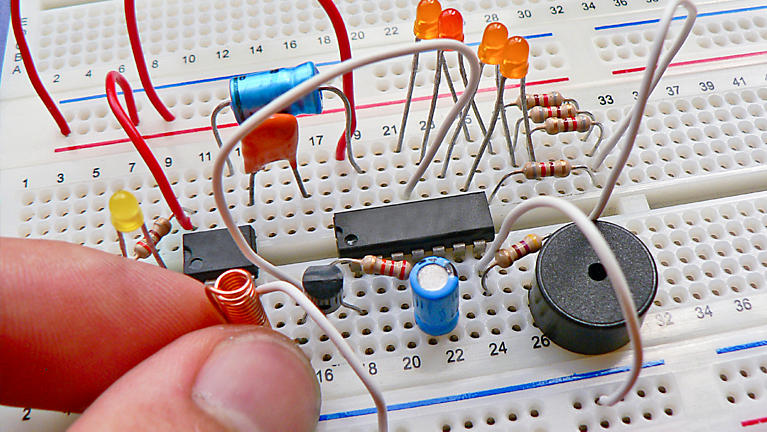Salam (May God Bless You). This article is about drawing circuits in their symbolical form. Since drawing original shapes of the component is very difficult we use symbols to represent the actual electronic components. This is useful as these ssymbols are understood universally and are easier and quicker to draw.
Connecting In Series and Parallel
Electrical components such as bulbs are connected in a circuit either in series or in parallel.  We can see the effect connecting components either way if we connect two bulbs as such. If connecting two bulbs in series, we can connect an ammeter on either point of the circuit to find that the current is same
We can see the effect connecting components either way if we connect two bulbs as such. If connecting two bulbs in series, we can connect an ammeter on either point of the circuit to find that the current is same  everywhere on the circuit. In case we connect a voltmeter in parallel to the bulbs, we can see that the p.d across each bulb is same and the total p.d of the bulbs make up the potential difference equal to the battery itself. By connecting more bulbs causes all the bulbs to lose their brightness soon and will break.
everywhere on the circuit. In case we connect a voltmeter in parallel to the bulbs, we can see that the p.d across each bulb is same and the total p.d of the bulbs make up the potential difference equal to the battery itself. By connecting more bulbs causes all the bulbs to lose their brightness soon and will break.
 In a parallel circuit, the amount of components connected will not matter to much but if you keep on adding components like a bulb they will soon burn out. If one bulb burns out this does not affect the other bulbs like it does in a series circuit. This is because the parallel circuit makes up two circuits in principle, due to this the current gains two paths to move.
In a parallel circuit, the amount of components connected will not matter to much but if you keep on adding components like a bulb they will soon burn out. If one bulb burns out this does not affect the other bulbs like it does in a series circuit. This is because the parallel circuit makes up two circuits in principle, due to this the current gains two paths to move.
When we connect an ammeter to various parts of the parralel circuit, we can observe that the current in both parts of the circuit is same but on the other part of the circuit where the two currents meet we see that the amount of current is  different, the sum of the two currents make up the total current. If a voltmeter is connected across the circuit, then the p.d across both components will be equal to the battery itself. This proves that the parallel circuits do not last as long as a series circuit but will be more efficient.
different, the sum of the two currents make up the total current. If a voltmeter is connected across the circuit, then the p.d across both components will be equal to the battery itself. This proves that the parallel circuits do not last as long as a series circuit but will be more efficient.
Diode
 A diode is made by silicon which is a semi-conductor. What a diode does is that it controls the direction of current flow. If a diode is in a forward position, this position is called forward biased, then the diode will help move the current forward only and no other direction. If it is connected in reverse then the diode will be negative biased and no current flows through the circuit.
A diode is made by silicon which is a semi-conductor. What a diode does is that it controls the direction of current flow. If a diode is in a forward position, this position is called forward biased, then the diode will help move the current forward only and no other direction. If it is connected in reverse then the diode will be negative biased and no current flows through the circuit.
Light Emitting Diode (LED)
A light emitting diode acts as a simple diode but emits light which is very useful to  know whether a circuit is working or not. Today many led bulbs can be bought as an alternative to a conventional bulb but they are expensive but much more efficient to the conventional bulbs.
know whether a circuit is working or not. Today many led bulbs can be bought as an alternative to a conventional bulb but they are expensive but much more efficient to the conventional bulbs.
Thermistor
 A thermistor is resistor which depends upon the temperature. When the temperature increases then the resistance decreases and vice versa.
A thermistor is resistor which depends upon the temperature. When the temperature increases then the resistance decreases and vice versa.
